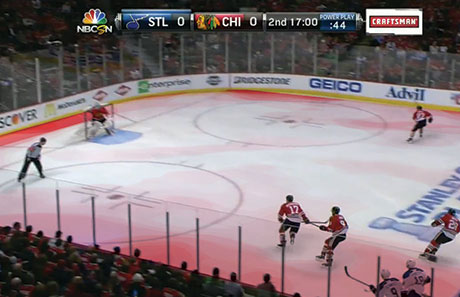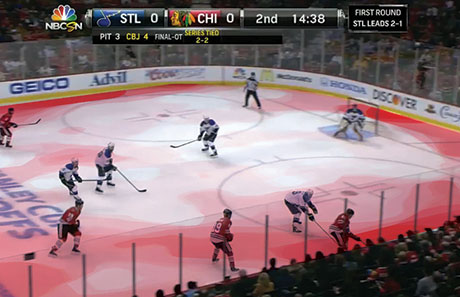One can’t help but feel sorry for the St. Louis Blues. Outside of a meltdown in the last 10 minutes of their series with the Blackhawks, they played Chicago to a virtual standstill. Looking at the Fenwick close metric for the series, in more than 254 minutes the teams were separated by one Corsi event (Blackhawks 235 to Blues 234), two shots (120 to 122) and 13 Fenwick events (158 to 171).
The Blues won the possession battle against one of the best possession teams in the league, but for a second season in a row could not hold on to an early advantage and win an extremely tight series. When I went deep into the data, the shot quality metrics—like the possession metrics—were virtually identical.


At even-strength there wasn’t much separating the two in the shots category. The Hawks had slightly greater forced lateral movement, but the difference was negligible. What the Hawks were able to do was force the Blues away from the slot at a greater rate than the Blues managed.
Chicago was generating shots closer to the net. Was that the difference between the two or was it something as simple as goaltending? Was Cory Crawford was better than Ryan Miller? While watching the series, I always had the feeling that the Blackhawks would win. The eye test was telling me the Hawks were in the driver’s seat because of the way the were controlling the offensive zone, but the Blues were winning the possession battle.
I focused on Game 5, the turning point in the series because it was essentially a 50-50 possession battle that was won on the final shot. To check my eye test, I manually tracked and mapped actual possession time by each team in the offensive zone. Corsi/Fenwick are great proxies for offensive zone time, but I wanted to test who actually possessed the puck. Essentially a literal interpretation of the term.
I found two teams that had virtually identical results taking two different routes to get there. The Blues’ possession success relied on a strong structure emphasizing controlled zone entries, but also a strong retrieval ability and controlling the cycle game on the boards. When they had the puck, they created their movement via quick passes rather than individual skill. The Blues would grind out zone time with diligent board work and attempt to capitalize on turnovers and defensive breakdowns.

We can see from the above graphic that most of St. Louis’s controlled possession was along the perimeter. The Blues also rarely maintained controlled entries through the middle of the ice and struggled more than the Hawks to possess pucks closer to the net.

Chicago also had a high rate of zone entries, but the skill guys like Patrick Kane, Marian Hossa, Patrick Sharp and Jonathan Toews were able to penetrate the middle of the zone as well as drive wide. The Hawks also relied less on retrievals and physically possessed the puck at a much greater rate. Although they still are systematically strong, their offence was more freewheeling. Kane was deployed like an NBA point guard or an elite midfielder. He moves around the offensive zone and manipulates passing lanes by carrying the puck while his teammates move in and out of space. The Blues surrendered the perimeter fairly easily, but Kane was also able to create breakdowns with his elite puck skills by moving towards the center of the ice.
Both systems work as effective possession models, but Chicago’s skill model causes slightly more havoc and creates slightly more space. Unfortunately it isn’t a system that any team can adopt because it requires an assortment of elite offensive puck-handling talent.
There has been a ton of great research leading to a better understanding of how coaching impacts possession on the team level and linking zone entries and their impact on possession on an individual level. We now understand which teams are strong possession-wise, what we continue to strive towards understanding is how and why.

